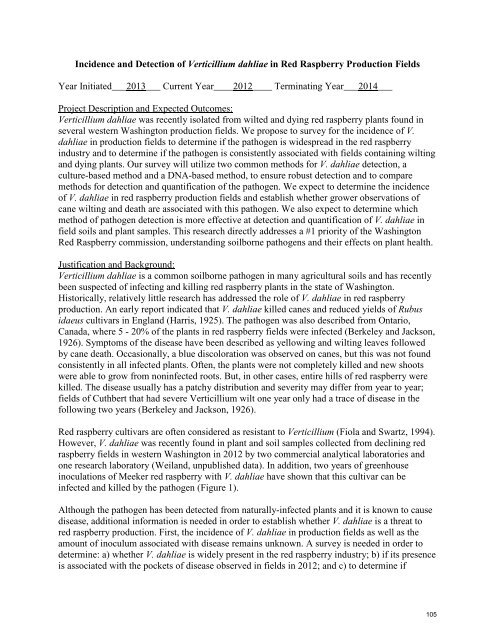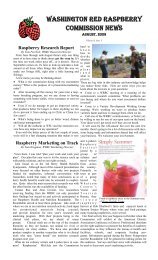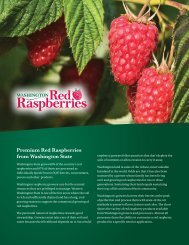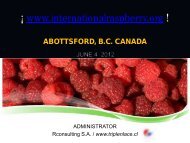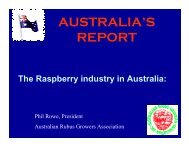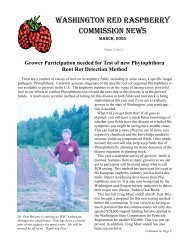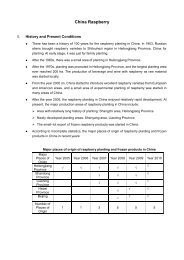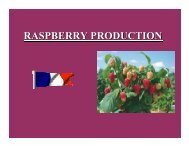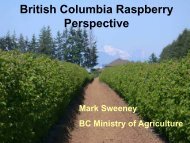2012 - Washington Red Raspberry Commission
2012 - Washington Red Raspberry Commission
2012 - Washington Red Raspberry Commission
Create successful ePaper yourself
Turn your PDF publications into a flip-book with our unique Google optimized e-Paper software.
Incidence and Detection of Verticillium dahliae in <strong>Red</strong> <strong>Raspberry</strong> Production Fields<br />
Year Initiated___2013___ Current Year____<strong>2012</strong>____ Terminating Year___2014___<br />
Project Description and Expected Outcomes:<br />
Verticillium dahliae was recently isolated from wilted and dying red raspberry plants found in<br />
several western <strong>Washington</strong> production fields. We propose to survey for the incidence of V.<br />
dahliae in production fields to determine if the pathogen is widespread in the red raspberry<br />
industry and to determine if the pathogen is consistently associated with fields containing wilting<br />
and dying plants. Our survey will utilize two common methods for V. dahliae detection, a<br />
culture-based method and a DNA-based method, to ensure robust detection and to compare<br />
methods for detection and quantification of the pathogen. We expect to determine the incidence<br />
of V. dahliae in red raspberry production fields and establish whether grower observations of<br />
cane wilting and death are associated with this pathogen. We also expect to determine which<br />
method of pathogen detection is more effective at detection and quantification of V. dahliae in<br />
field soils and plant samples. This research directly addresses a #1 priority of the <strong>Washington</strong><br />
<strong>Red</strong> <strong>Raspberry</strong> commission, understanding soilborne pathogens and their effects on plant health.<br />
Justification and Background:<br />
Verticillium dahliae is a common soilborne pathogen in many agricultural soils and has recently<br />
been suspected of infecting and killing red raspberry plants in the state of <strong>Washington</strong>.<br />
Historically, relatively little research has addressed the role of V. dahliae in red raspberry<br />
production. An early report indicated that V. dahliae killed canes and reduced yields of Rubus<br />
idaeus cultivars in England (Harris, 1925). The pathogen was also described from Ontario,<br />
Canada, where 5 - 20% of the plants in red raspberry fields were infected (Berkeley and Jackson,<br />
1926). Symptoms of the disease have been described as yellowing and wilting leaves followed<br />
by cane death. Occasionally, a blue discoloration was observed on canes, but this was not found<br />
consistently in all infected plants. Often, the plants were not completely killed and new shoots<br />
were able to grow from noninfected roots. But, in other cases, entire hills of red raspberry were<br />
killed. The disease usually has a patchy distribution and severity may differ from year to year;<br />
fields of Cuthbert that had severe Verticillium wilt one year only had a trace of disease in the<br />
following two years (Berkeley and Jackson, 1926).<br />
<strong>Red</strong> raspberry cultivars are often considered as resistant to Verticillium (Fiola and Swartz, 1994).<br />
However, V. dahliae was recently found in plant and soil samples collected from declining red<br />
raspberry fields in western <strong>Washington</strong> in <strong>2012</strong> by two commercial analytical laboratories and<br />
one research laboratory (Weiland, unpublished data). In addition, two years of greenhouse<br />
inoculations of Meeker red raspberry with V. dahliae have shown that this cultivar can be<br />
infected and killed by the pathogen (Figure 1).<br />
Although the pathogen has been detected from naturally-infected plants and it is known to cause<br />
disease, additional information is needed in order to establish whether V. dahliae is a threat to<br />
red raspberry production. First, the incidence of V. dahliae in production fields as well as the<br />
amount of inoculum associated with disease remains unknown. A survey is needed in order to<br />
determine: a) whether V. dahliae is widely present in the red raspberry industry; b) if its presence<br />
is associated with the pockets of disease observed in fields in <strong>2012</strong>; and c) to determine if<br />
105


